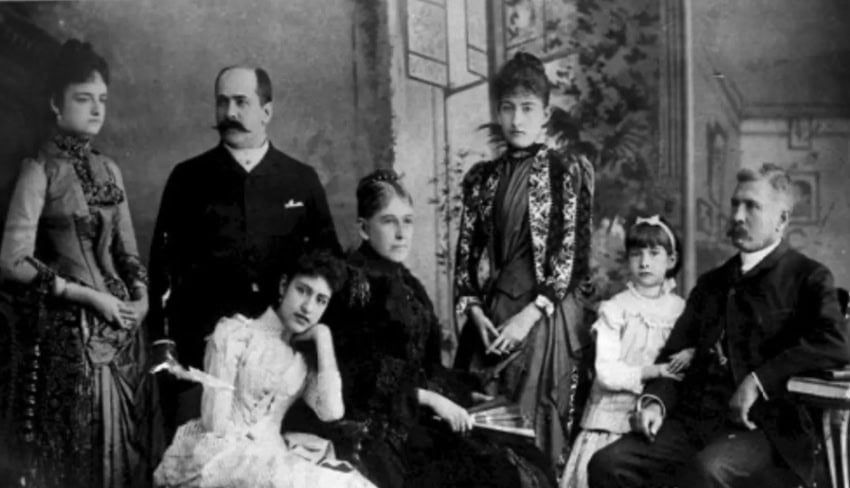The first time I heard the term “casa chica” was years ago, before I moved to Mexico. A friend and I were chatting about our favorite topic — men — and she referenced the term. “A what?” I asked, understanding the literal definition (small house) but not the societal one. “A casa chica! You know, the house where the mistress and her kids live. It’s a Mexican thing.”
In fact, I didn’t know, but it was enough to pique my interest. After digging a bit, I discovered that a casa chica, beyond mere infidelity, was a complex social institution that has shaped contemporary attitudes on marriage, class and power in Mexico. How many of these apartments I walk by in Mexico City are hiding second families? As it turns out, not many. Laws have been put in place to prevent such circumstances. But a mere 150 years ago, the capital would have been crawling with them.
Colonial origins and Catholic constraints

According to the Universidad Nacional Autónoma de México (UNAM)’s Revista de Derecho Privado, la casa chica is a “formal and stable relationship in which a married man establishes a second home with another woman.” It was once described by the Los Angeles Times as “an enduring Mexican institution” despite parallels in other Catholic colonial societies — particularly the Spanish, French and Portuguese Caribbean, where concubinage and mixed unions were tolerated as long as they were discreet. However, unlike Europe, where mistresses were typically of noble blood, elite Mexican men sought lovers among the Indigenous or mestizo classes who lacked what they could offer: financial stability.
In New Spain, only church-sanctioned marriages were considered legitimate and divorce was forbidden. Mexico’s strict societal rules meant Europeans married Europeans; mestizas and Indigenous women were considered morally suspect and sexually promiscuous. Therefore, marriages were more a product of class arrangement than a love relationship and thus, la casa chica was born.
In part, the second home derived from desire — a place for the man to relax, as it were — but it also arose from prestige. Only men with substantial wealth had the means to support two households, often with two sets of children. Having a casa chica showcased status and elite ranking, as those from the lower rungs of Mexican society could never afford it.
The art of maintaining a double life
Logistically, there was a lot to juggle — whispering neighbors, in-house staff and daily agendas — so maintaining a casa chica was an art in itself. Archival research reveals that during the Porfiriato (1876–1911), secondary households clustered in middle-class neighborhoods like Santa María la Ribera. The more casa chicas on the block, the better chance the arrangement would be accepted by the local community. Moreover, these neighborhoods were a safe distance from the primary household, ensuring schools and church services would never overlap. Of course, there was less chance to be caught red-handed, and men had to carefully coordinate schedules between their two households. Work, business trips or seasonal estates were often used as cover for visits to their second families.
Since the secondary house ran as a carbon copy of the primary house, it had its own set of staff that had to be managed and, above all, trusted. The job was given to Indigenous or lower-class mestizo women whose loyalty was compensated with room and board as opposed to formal wages. Servants who broke confidence faced not just dismissal but the inability to secure future employment. This was a preferable arrangement — it was easy to hide the payment. As for the secondary woman, the money she needed to live and raise their children came in the form of “donations” (INEHRM). When the men died, women from casa chicas faced destitution unless they had been fortunate enough to receive property donations or have their children acknowledged in wills.
The primary wife and family remained in an equal state of limbo. Adultery was illegal under the 20th-century Penal Code, but that didn’t mean it was enforced. Prosecutions could proceed only upon a wife’s formal complaint, at which point she’d risk losing both her partnership and her social dignity. It wasn’t until the 1983 amendments to the Federal Civil Code that a turning point came to Mexican family law. For the first time, a concubinato (non‑marital, long‑term cohabitation) was formally recognized as a legitimate domestic category. This extended inheritance rights to partners who had either cohabited for two years or shared children, a reflection of the fight put up by scholars such as Patricia Kuri García, who argued that Mexico’s “invisible families” deserved legal recognition.
The decline of an institution

What Guadalupe Loaeza once described as the “golden age of double lives” would, like all golden ages, eventually come to an end.
Three major trends contributed to the casa chica’s decline: expanding divorce laws, women entering the professional workforce and feminist movements challenging “institutionalized infidelity.” Mexico’s infamous double standards were now at risk, and the respect once garnered by sustaining a casa chica started to diminish. By the 21st century, a casa chica was no longer thought of as an art, but rather, a plain old love affair.
When labeled as such, this particular extramarital activity pervades with tenacity in Mexico — according to a 2019 study made by Universidad Autónoma de Nuevo León in Monterrey, around 6 of 10 men and 3 of 10 women reported having at least one current or previous partner outside of their marriage in the previous year. Another 2025 study by the Instituto Nacional de Estadística y Geografía (INEGI) found that 30.6% of Mexican men and 12.8% of Mexican women admitted to sexual infidelity within the last year.
If we take the average of these two statistical findings, roughly 45% of men and 21% of women have — admittedly — strayed. Begging the question: has the casa chica truly fallen, or has it simply adopted a modern form?
UNAM sociologist Lucía Melgar claims the latter, saying we’re simply living in “the dematerialized casa chica era,” where relationships are maintained through apps and messaging platforms without the formal domestic architecture of the past — in other words, the casa chica without the casa.
Social media and dating apps have made secret relationships accessible beyond the wealthy elite who once monopolized the role. However, these contemporary arrangements lack the economic protection and semi-legitimate social status that historical casa chicas provided. The legacy of the casa chica culture persists in Mexican attitudes that still show greater tolerance for male infidelity than female, though this gap continues to narrow among younger generations.
Famous cases and historical figures

Mexican history is riddled with rumors of famous men and their hidden — and sometimes not so hidden — lovers, revealing how casa chicas intersected with power, politics and public image in Mexican society.
Stories of Emperor Maximilian I have been swirling for centuries regarding his supposed mistress and illegitimate son, for whom he allegedly kept a secondary home near Cuernavaca. Historians such as Enrique Krauze and Tina Schwenk dispute the claim, but that doesn’t stop the legend from living on.
Francisco “Pancho” Villa is reported to have had multiple recognized spouses and secondary households. Mexico Desconocido claims he had up to 23 partners and at least 26 children despite his civil marriage to Luz Corral de Villa of Chihuahua. Villa’s multiple alliances served both personal and political purposes; he likely used these relationships to guarantee regional loyalties during the Revolution. It’s said that 22 widows attended his funeral.
A married José López Portillo (President of Mexico from 1976 to 1982) met actress Sasha Montenegro in 1984 in Spain, and within three years fathered two of their children. After his presidency ended, he divorced his wife and married Sasha, provoking a national scandal that went beyond romantic limits and crossed into political corruption. After the pair moved into one of four mansions on his 12-hectare compound in an upscale Mexico City neighborhood, revelations emerged that it had been built with redirected state funds.
Bethany Platanella is a travel planner and lifestyle writer based in Mexico City. She lives for the dopamine hit that comes directly after booking a plane ticket, exploring local markets, practicing yoga and munching on fresh tortillas. Sign up to receive her Sunday Love Letters to your inbox, peruse her blog or follow her on Instagram.
